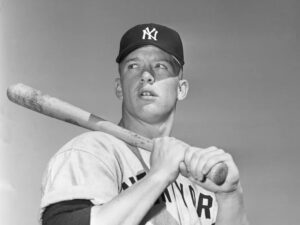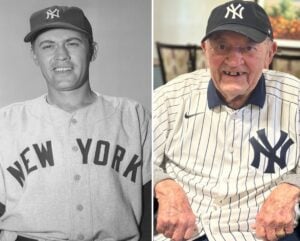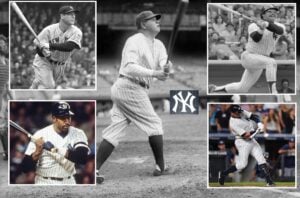Bill Dickey: The Yankees great who made Yogi Berra a legend

Daniel Nolan
More Stories By Daniel Nolan
- Mother’s Day: How Anthony Volpe’s mom molded him into a Yankee phenom
- Ben Rice demoted to Triple-A amid MLB struggles, Luis Gil begins rehab in Yankees roster moves
- Yankees’ Oswaldo Cabrera admits mistake in ninth-inning pitch clock violation: ‘It’s my fault’
- Boone confirms Anthony Rizzo’s likely Sunday activation for Yankees
- Yankees 5-6 Cardinals: Stanton’s near Grand Slam falls short as St. Louis earn first-ever win at new Yankee Stadium
- December 17, 2023
- 12:23 pm
- No Comments
Table of Contents
| Position | Catcher |
| Active years | 1928 – 1946 |
| Teams (years) | New York Yankees (1928–1943, 1946) |
| Draft | 1925 (Chicago White Sox) |
| Debut | August 15, 1928, for the New York Yankees |
| Last game | September 8, 1946, for the New York Yankees |
| Date of Birth | June 6, 1907 |
| Native place | Little Rock, Arkansas, U.S. |
| Batted | Left |
| Threw | Right |
| All-Star | 11× All-Star (1933, 1934, 1936–1943, 1946) |
| World Champions | 7× World Series champion (1932, 1936–1939, 1941, 1943) |
| Shirt retired | New York Yankees Number 8 |
| Hall of Fame year | 1954 (80.16% seventh ballot) |
| Legacy | Monument Park honoree, Bob Feller Act of Valor Award (2013) |
| Manager of teams | New York Yankees (1946) |
| Coach of team | New York Yankees (1949 to 1957) |
| Nickname | The Man Nobody Knows |
In 1928, a pivotal moment awaited Bill Dickey as he stood on the precipice of his professional baseball career. After a stint with the Class D Jackson, Mississippi team, he found himself on waivers, a crossroads in his journey. It was during this time that the astute Yankees scout, Johnny Nee, exhibited unwavering confidence in Bill Dickey’s potential. With resolute determination, Nee boldly declared to the venerable Yankee General Manager, Ed Barrow, “I will quit scouting if this boy does not make good.”
In 1928, the baseball world witnessed the debut of a future Hall of Fame legend, Bill Dickey. His ascent to prominence was swift, as he assumed the mantle of the Yankees’ regular catcher in the ensuing year. Sharing the diamond with none other than the iconic Babe Ruth, Bill Dickey endeavored to emulate the Bambino’s distinctive style throughout his illustrious 19-year career. His impressive résumé included 11 All-Star selections and a remarkable seven World Series championships.
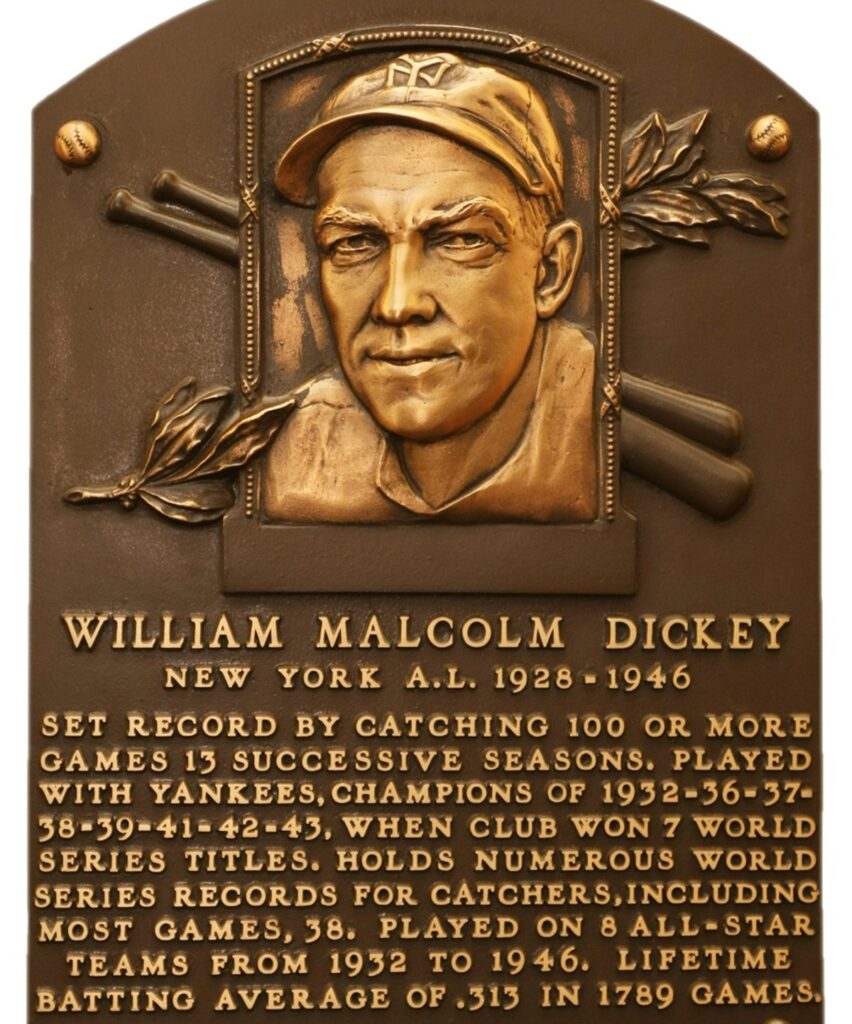
Bill Dickey’s prowess at the plate shone brightly, with consistently reaching double-digit home runs on nine occasions, achieving the coveted 100 RBI milestone four times, and maintaining a batting average exceeding .300 for an astonishing 11 seasons. Yet, his impact extended beyond batting; his defensive skills, formidable arm, and unparalleled ability to call a game were equally remarkable. Yankee pitcher Charlie Devens noted Bill Dickey’s uncanny knack for anticipating the next pitch, ensuring that he was always one step ahead of the opposing batters. His throwing arm was, without a doubt, second to none.
In the twilight of his playing career, in 1946, Bill Dickey embarked on a new role as the player-manager for the Yankees. His association with the Yankees organization had spanned from 1928, and it endured until 1943, temporarily interrupted by his service in the United States Navy during World War II. Bill Dickey’s return to the Yankees in 1946 marked a historic moment, as he not only continued to be a player but also took the helm as a manager. The curtain fell on his remarkable playing career at the conclusion of the 1946 season. Nonetheless, his enduring connection with the Yankees persisted in 1949 when he assumed a coaching role, passing on his wealth of knowledge to the young and promising Yogi Berra, imparting the finer points of the catching position.
The passing of the torch from one legendary figure to another marked a defining chapter in the Yankees’ history. In the year 1949, Bill Dickey extended his mentorship to a struggling Yogi Berra, boldly predicting that his protege would ascend to the position of premier catcher in the American League within a mere two years. Astonishingly, Berra fulfilled that prophecy in just a year, solidifying his place as the preeminent backstop extraordinaire and setting the stage for an iconic era in the annals of the New York Yankees.
Throughout Bill Dickey’s illustrious playing career, the New York Yankees made their way to the grand stage of the World Series an impressive nine times, emerging victorious with eight championship titles. His prowess and skill earned him a spot in 11 All-Star Games, solidifying his status as one of the game’s most elite catchers. Following his remarkable tenure as a player, he briefly stepped into the role of player-manager, contributing his wisdom to guide the Yankees. His impact was further underscored as he played a pivotal role in securing an additional six World Series titles for the Yankees, this time as a coach. In recognition of his extraordinary contributions to the sport, Bill Dickey was rightfully enshrined in the Baseball Hall of Fame in the year 1954.
Early life and career
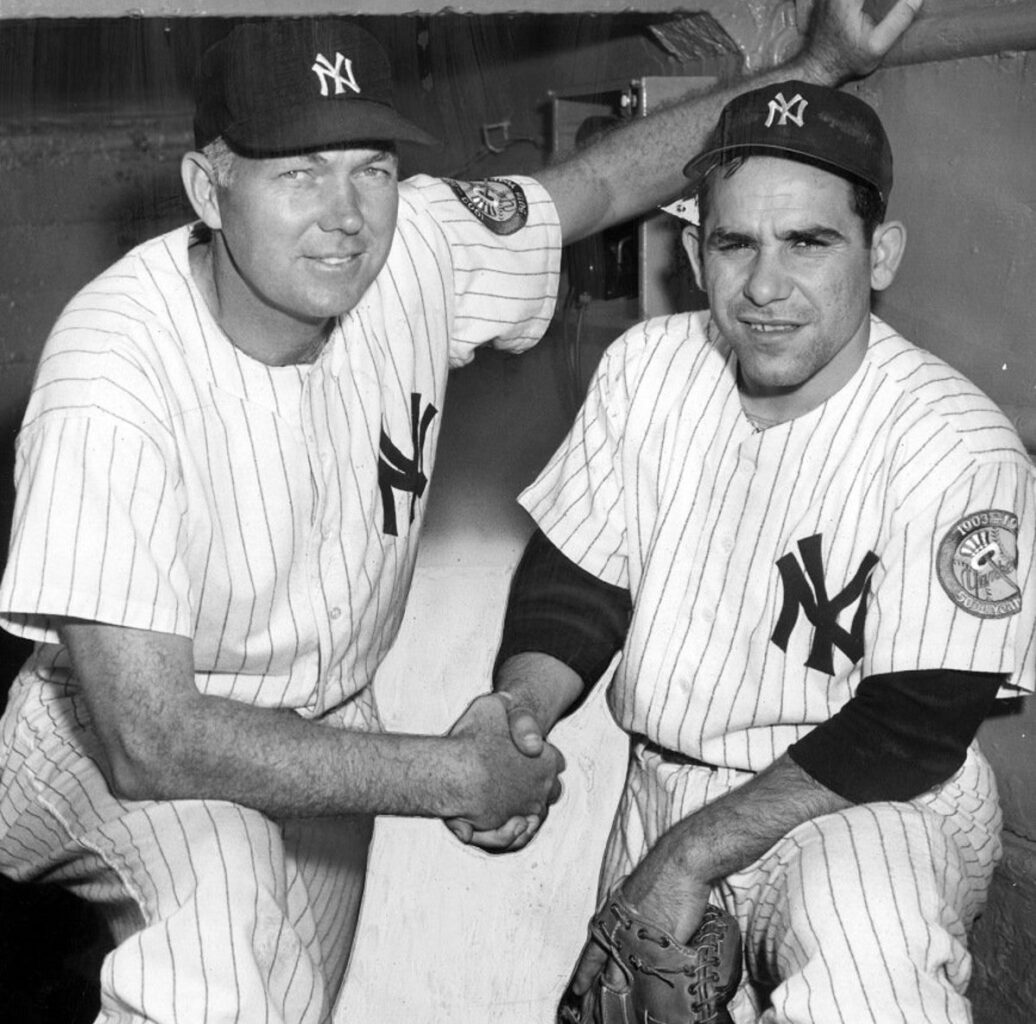
William Malcolm Dickey, born in Bastrop, Louisiana on June 6, 1907, hailed from a family deeply entrenched in a profound love for the sport of baseball. His father, John Dickey, had once graced the diamond, displaying his prowess both as a pitcher and catcher for Memphis in a semipro league. His older brother, Gus, showcased his baseball talents by playing second base and pitching in the East Arkansas Semipro League. The family’s rich baseball legacy extended even further, with Bill’s younger brother, George “Skeets” Dickey, enjoying a noteworthy six-season career as a major-league catcher, representing Chicago and Boston in the American League.
Growing up in Kensett, Arkansas, young Bill Dickey found himself irresistibly drawn to the world of baseball. His early days saw him taking his place at second base for the town team, where he exhibited his budding talents. In time, he transitioned to showcase his pitching skills during his years at Searcy High School. After graduating, he embarked on a journey through the realm of sports, pursuing his education at Little Rock College. Here, he donned the role of a guard on the football field while also displaying his prowess on the pitcher’s mound for the college’s baseball team.
A serendipitous turn of events, coupled with some convincing words from his friend Jimmy Froley, guided Bill Dickey toward an unforeseen opportunity. When Froley found himself unable to fulfill his commitments as the regular catcher for a semipro team in Hot Springs, Arkansas, he fervently implored Bill Dickey to step into his shoes. Initially hesitant, Bill Dickey eventually succumbed to the persuasions of fate and approached Hot Springs’ manager, Roy Gillenwater, to offer his services. Bill Dickey wasted no time in making a remarkable impression on Gillenwater, displaying not only his potent throwing arm but also catching the discerning eye of Lena Blackburne, the manager of the Little Rock Travelers in the Southern Association. Although Blackburne had originally journeyed to Hot Springs with the intention of scouting an outfielder named Paul Philips, he departed with a signed contract from Bill Dickey in the year 1925.
At the tender age of eighteen, Bill Dickey embarked on a well-worn path in relentless pursuit of his baseball dreams. In 1925, he made a fleeting appearance in just three games for Little Rock before making a transition to Muskogee in the Class C Western League in the year 1926. In Muskogee, Bill Dickey astounded with his batting skills, boasting a formidable .283 batting average across 61 games. Towards the culmination of that season, he made a return to Little Rock, setting the field ablaze with a blazing .391 batting average in 17 games.
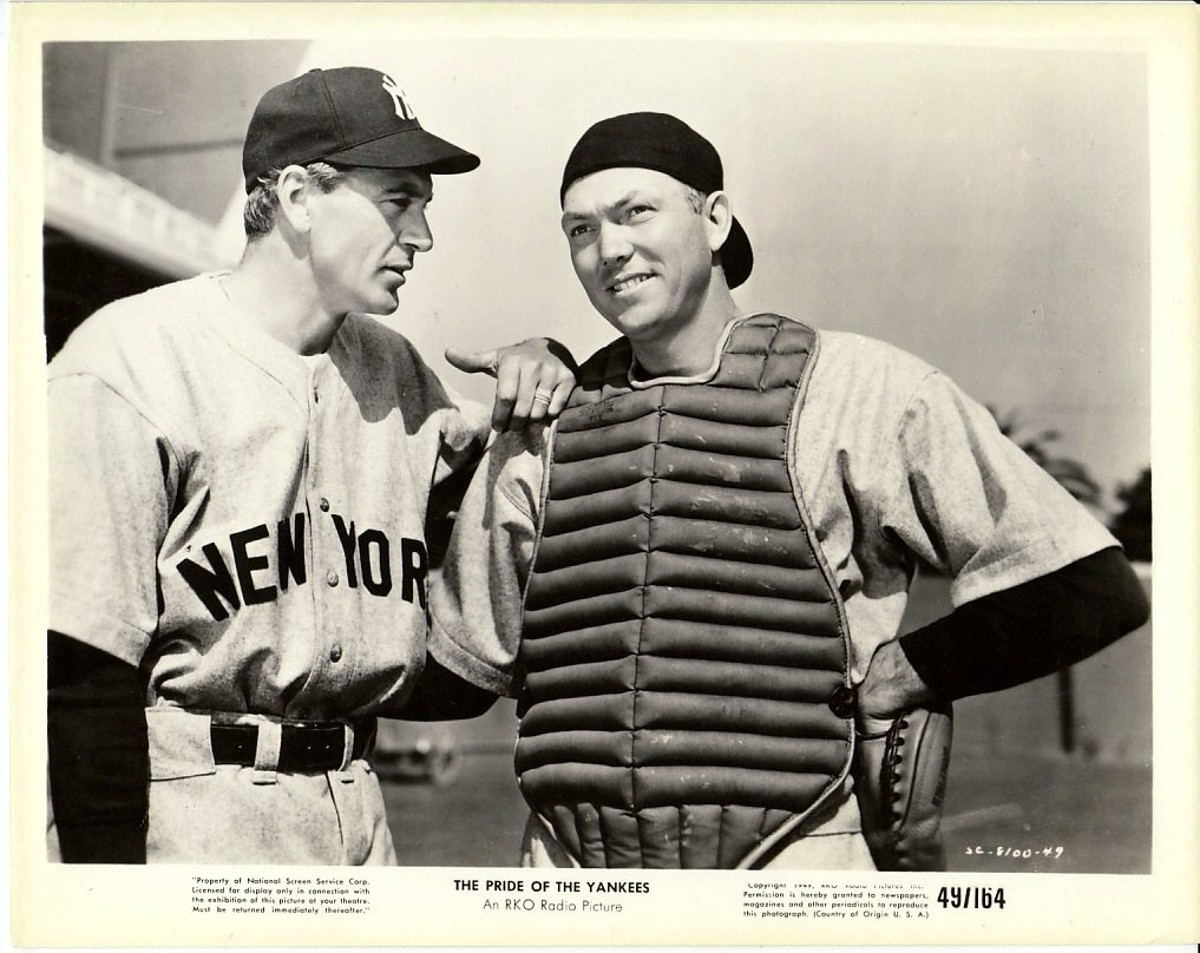
In the following year, 1927, Bill Dickey continued his odyssey by joining the Jackson Senators, where he showcased his talents in 101 games. Throughout that season, he exhibited his prowess with a commendable .297 batting average, securing three home runs while maintaining an impressive fielding percentage of .989. His excellence as a catcher was undeniable, as evidenced by his tally of 84 assists, coupled with a mere nine errors, thus solidifying his reputation as an ascending luminary in the realm of baseball.
In the pinstripes
The Jackson Senators eventually released their hold on Bill Dickey, paving the way for the New York Yankees to capitalize on the opportunity, all thanks to the persuasive endeavors of scout Johnny Nee. Nee’s unwavering confidence in Dickey was made resoundingly clear when he sent a resolute message to the team’s general manager, Ed Barrow, boldly stating, “I will quit scouting if this boy does not make good.” The Yankees wasted no time, promptly forking out the $12,000 waiver fee, thus absolving Nee from the daunting prospect of fulfilling his audacious offer to Barrow. Following a brief return stint in Little Rock, where he maintained a sterling .300 batting average across 60 games, Bill Dickey earned a well-deserved promotion to Buffalo in the International League. However, fate had different plans, guiding him downstate to the iconic borough of the Bronx and the parent Yankees.
Bill Dickey’s momentous major-league debut unfolded on the hallowed grounds of Yankee Stadium on August 15, 1928, as he stepped in to replace the ailing Benny Bengough. His inaugural hit graced the field nine days later, on August 24, when he launched a triple off the formidable George Blaeholder of the St. Louis Browns. Bill Dickey concluded his rookie year by participating in ten games, bearing witness as the Yankees clinched their third consecutive pennant and went on to sweep the Cardinals, securing their second consecutive World Series title.
The dawn of the 1929 season heralded the transition from the esteemed Murderers’ Row teams that had reigned supreme in the late 1920s to the era of the Bronx Bombers in the 1930s. While the Yankees had thrived during the Murderers’ Row era, they had encountered a relative deficiency at the catcher position. Bill Dickey’s arrival proved to be the catalyst for change; within a mere two years, he had displaced all three catchers on the Yankees’ roster. Starting in 1929, Bill Dickey assumed the mantle of the catcher’s gear, a role he would embrace for at least 100 games in each of the ensuing 13 seasons.
As an emerging hitter, Bill Dickey found himself under the pervasive influence of the illustrious Yankees sluggers. Frequently, the young left-handed batter sought to mirror the prowess of legends like Babe Ruth, Bob Meusel, Lou Gehrig, or Tony Lazzeri. Occupying the seventh spot in the lineup, Bill Dickey made an enduring mark in the year 1929. He showcased an impressive batting average of .324, along with 10 home runs and 65 runs batted in – astonishing statistics for a rookie bearing a distinctive Ozark drawl. What’s even more remarkable is that over the course of 130 games, he led all catchers with 95 assists and orchestrated 13 double plays. As Miller Huggins had astutely foretold, Bill Dickey was undeniably embarking on a remarkable and enduring career.
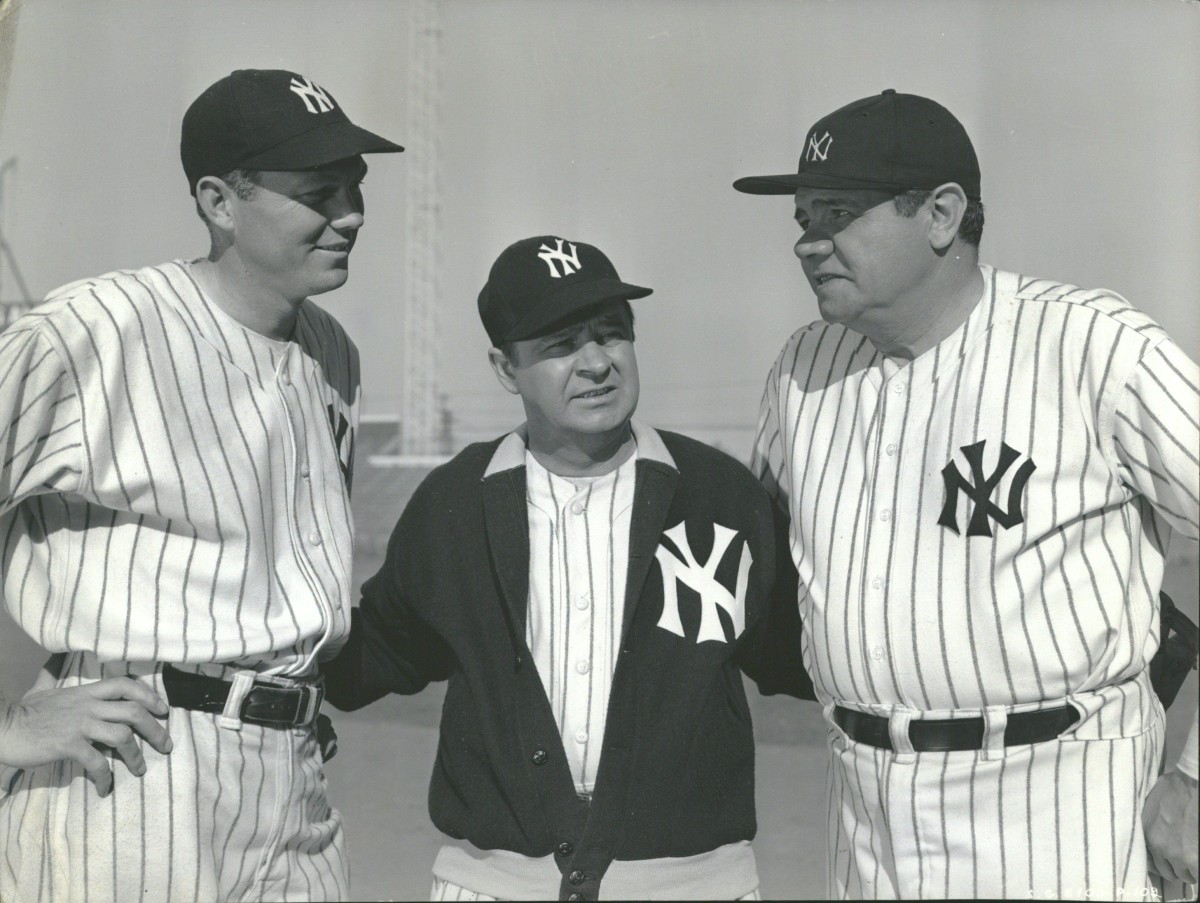
In the 1930 season, a year marked by the dominant presence of Ruth and Gehrig, who collectively amassed an astounding 90 home runs and 448 RBIs, Bill Dickey continued to astound. His .339 batting average stood as an irrefutable testament that his stellar rookie campaign had been no mere happenstance. With the formidable trio of Yankees leading the charge, the team averaged an impressive 6.9 runs per game, setting the baseball world abuzz with excitement.
The consistent Yankees pillar
In spite of their collective prowess, New York found themselves trailing the Athletics in the year 1931. Nonetheless, Bill Dickey remained a pillar of unwavering consistency. Behind the plate, he committed a mere three errors, showcasing his defensive acumen. Simultaneously, he wielded a potent bat, compiling a .327 batting average and driving in 78 runs. His standout moments on the field included a remarkable five-hit game on May 17 at Detroit’s Navin Field and a memorable seven RBIs during an emphatic 17-0 victory over the Browns at Yankee Stadium on September 17. Bill Dickey’s exceptional contributions did not go unnoticed, earning him the first of six nominations as a catcher to The Sporting News All-Star Team.
A highly controversial incident unfolded on July 4, 1932, during the first game of a doubleheader in Washington, etching a chapter in baseball history. In the bottom of the seventh inning, a daring suicide squeeze play was executed, setting the stage for a sequence of events that would resonate through the annals of the sport. Washington’s fleet-footed right fielder, Carl Reynolds, embarked on a sprint from third base towards home, but when the bunt attempt faltered, he retreated to safety. Then, in a bizarre twist of fate, Bill Dickey’s throw to third baseman Joe Sewell took an unfortunate turn, resulting in a mishandling that prompted Reynolds to launch a second dash for home. In this pivotal moment, a collision of considerable consequence occurred, with Bill Dickey delivering a punch that fractured Reynolds’ jaw in two places. He firmly believed that Reynolds had harbored ill intent in his actions. In response to this controversial incident, American League president Will Harridge levied a substantial $1,000 fine on Bill Dickey and suspended him from the game for a period of 30 days.
Despite the cloud of controversy, the Yankees pressed forward to seize the pennant, finishing a commanding 13 games ahead of Philadelphia, and ultimately completing a resounding sweep of the Cubs in the World Series. Bill Dickey’s performance continued to shine brightly as he notched a .310 batting average, 15 home runs, and 84 RBIs during the season. His true moment of glory materialized in his maiden World Series appearance, where he exhibited his prowess at the plate, amassing an impressive 7-for-16 record, all while remaining impeccable behind the catcher’s mask.
Merely three days after the culmination of the World Series on October 5, Bill Dickey took a momentous step in his personal life, tying the knot with Violet Arnold, a New York showgirl. The wedding ceremony took place at St. Mark’s Church in Jackson Heights, New York. In 1935, the couple celebrated the arrival of their first child, Lorraine, into the world.
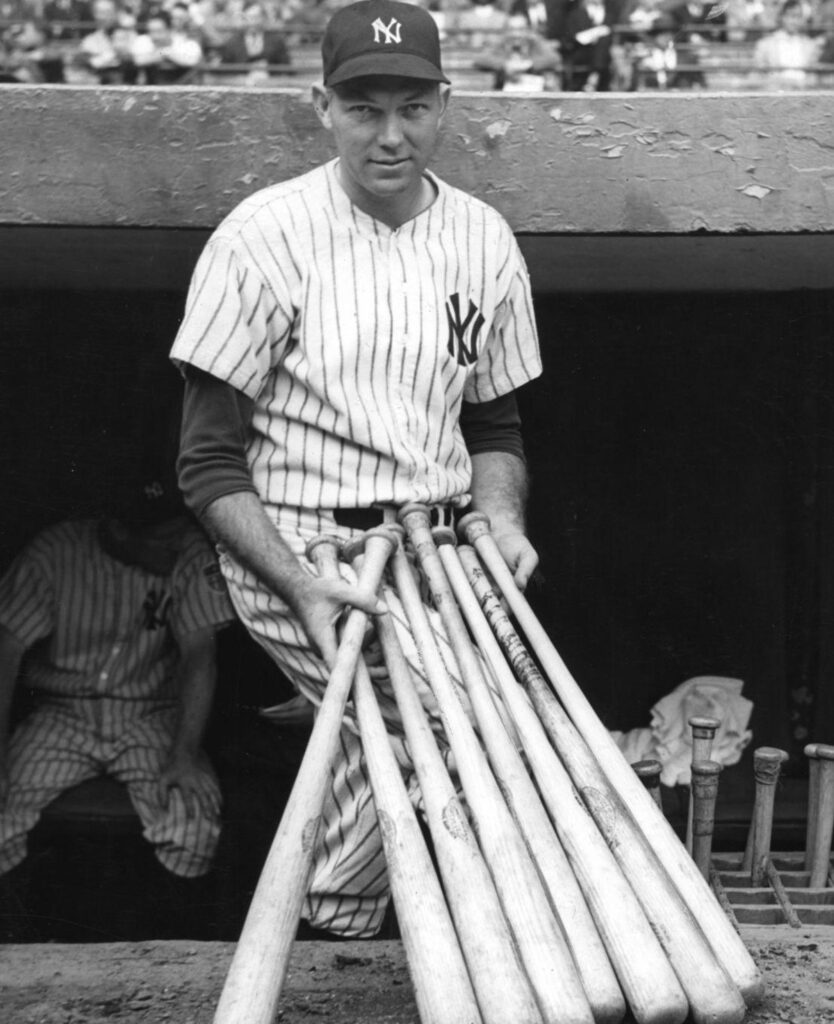
The Yankees faced a brief three-year hiatus before reclaiming another pennant, after securing a second-place finish in the intervening years. Bill Dickey, in his characteristically dependable manner, continued to excel both at the plate and in his role behind the catcher’s mask during the 1933 season. His remarkable performance earned him a well-deserved spot on The Sporting News All-Star Team for the second consecutive year. His impressive statistics included a .318 batting average, 97 RBIs, and a mere six errors, further cementing his reputation as a pillar of strength in the game.
The year 1933 etched a momentous milestone in the annals of baseball history with the inaugural All-Star Game. A national fan poll played a pivotal role in determining the players who would grace this historic event, and to no one’s surprise, Bill Dickey emerged as the resounding choice for the American League’s catcher position, amassing nearly 123,000 more votes than his counterpart, Mickey Cochrane of Philadelphia.
Growing stronger
An intriguing chapter in Bill Dickey’s career unfolded when he assumed the role of Joe Sewell’s roommate, a position once occupied by the legendary Lou Gehrig. Despite their apparent disparities, with Dickey hailing from the East Coast and speaking with a distinct New York accent, while Gehrig possessed a Southern drawl and hailed from a small college in Little Rock, they forged an unbreakable bond. Bill Dickey himself reflected on this, stating, “I was a close friend of Gehrig’s long before I succeeded Joe Sewell as his roommate,” underscoring the profound connection they shared.
In 1934, Bill Dickey once again secured a well-deserved spot on the All-Star Game roster, and this time, he graced the field. He left an indelible mark in the second inning, putting an end to Carl Hubbell’s streak of five consecutive strikeouts against future Hall of Fame members, which included Ruth, Gehrig, Jimmie Foxx, Al Simmons, and Joe Cronin. However, Bill Dickey’s regular season took an unfortunate turn when he encountered an untimely setback. On August 22, during a game against Cleveland, he suffered a fractured second finger on his right hand. The injury transpired in the ninth inning when a foul tip off the bat of Cleveland pitcher Mel Harder struck his finger.
The subsequent years witnessed the Yankees finishing as runners-up to the formidable Detroit Tigers in both 1934 and 1935, signifying a transitional period in the Bronx. Notably, 1934 marked the conclusion of Babe Ruth’s illustrious tenure with the Yankees. However, 1936 ushered in a new era for the Bronx Bombers with the arrival of Joe DiMaggio, and they rebounded with remarkable success, securing the World Series championship in six of the next eight years.
In the year 1936, Bill Dickey experienced a season that would define his career, showcasing an extraordinary .362 batting average that ranked him third in the league, surpassed only by Luke Appling (.388) and Earl Averill (.378). Accompanied by 22 home runs and 107 RBIs, he embarked on a four-year streak, consistently hitting at least 20 home runs and driving in 100 runs annually. His prowess behind the plate was equally remarkable during this period, as Bill Dickey led the league in putouts (1937-1939), assists (1937-1938), and fielding percentage (1939). The Yankees stamped their dominance on the season with a record of 102-51 in 1936, securing the pennant with an imposing lead of 19½ games over Detroit. While the Bronx Bombers outperformed their crosstown rivals, the Giants, to claim the World Series in six games, Bill Dickey’s offensive contributions were a mix. He recorded a 3-for-25 performance at the plate, resulting in a batting average of .120. Nonetheless, he did shine in Game Two, going 2-for-5 with a home run and five RBIs, but faced struggles, going 1-for-20 in the remaining five games.
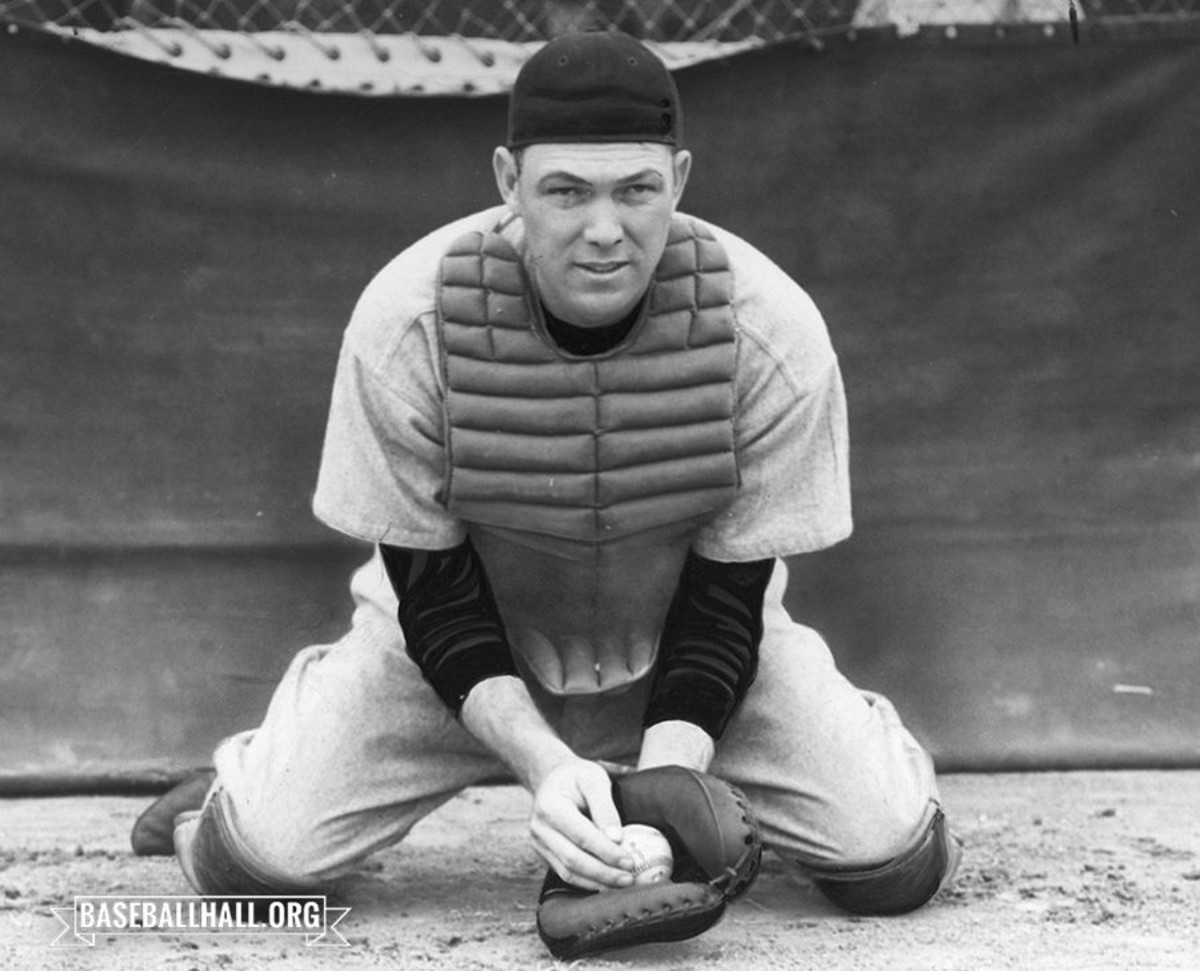
The ensuing three years bore witness to a triumphant era for the Yankees, as they clinched consecutive World Series championships, defeating the Giants (1937), Cubs (1938), and Reds (1939) in sweeping fashion. Manager Joe McCarthy’s strategy of fluidly employing pitchers in interchangeable roles, including starters taking on relief duties and relievers becoming starters, elevated Bill Dickey as the on-field manager. His leadership and influence played an instrumental role in optimizing the performance of the Yankees’ pitching staff, occasionally leading to instances where a pitcher’s departure from the team resulted in improved performances elsewhere.
In 1937, Bill Dickey showcased his power at the plate, achieving his highest home run tally with 29, in addition to 35 doubles, 176 hits, and 133 RBIs, all of which stood as career highs. A remarkable seven-day stretch from July 29 to August 4 witnessed Bill Dickey’s immense power. He launched a bases-empty home run on the 29th, propelling the Yankees to a 7-6 victory over the visiting Detroit Tigers. On the 31st, he added a two-run shot in a 9-6 loss to the Browns. The pinnacle of his power surge occurred on August 3 and 4 when he hit grand slams in consecutive games against the White Sox, one-off John Whitehead and the other off Vern Kennedy. This exceptional feat tied a record initially set by Babe Ruth for consecutive days with grand slams.
In 1938, despite a mid-September six-game losing streak, the Yankees secured the pennant with a comfortable 9½-game lead over the Red Sox. They proceeded to sweep the Cubs in the World Series, with Bill Dickey contributing a 6-for-15 performance at the plate.
In 1939, despite the absence of Lou Gehrig, the Yankees continued their winning streak, surpassing Boston by a commanding 17-game margin to secure the top spot in the American League. During this season, Bill Dickey maintained a .302 batting average, marking the last full season where his average exceeded .300. Among his 24 home runs, a memorable three came on July 26 during a game against the St. Louis Browns. In the World Series, he further showcased his power by launching two home runs and driving in five runs as the Yankees once again swept their opponents, this time, the Cincinnati Reds.
The year 1940 ushered in a fiercely contested pennant race for the Yankees, culminating in a third-place finish, despite their winning 10 of their last 12 games. They found themselves two games adrift of the victorious Tigers and one game behind the second-place Cleveland. Bill Dickey, now 33 years old, faced his most challenging season at the plate, as his batting average dipped to .247. He managed to hit only nine home runs and drive in 54 runs, sparking concerns about whether age was beginning to catch up with him. It was his 12th season of enduring the rigors of catching in more than 100 games, and it marked a year of sporadic appearances for the seasoned catcher.
However, both the Yankees and Bill Dickey made a triumphant return in 1941. The season marked several “lasts” for him, as he appeared in 109 games, making it the 13th and final season in which he crossed the century mark in games played. He also led the league in fielding for the last time, boasting an impressive .994 fielding average. Additionally, it marked the final occasion he would be honored with a spot on The Sporting News All-Star Team. Bill Dickey’s batting average for the season improved to .284, and he contributed 71 RBIs to the team’s cause. Notably, he embarked on a 21-game hitting streak in games that he started during the early part of the season. Under his leadership, the Yankees comfortably secured the pennant, finishing 17 games ahead of Boston, and went on to defeat Brooklyn in five games in the World Series.
Amidst their achievements, the 1941 season was overshadowed by a deep sense of sorrow when, on June 2, the legendary Lou Gehrig lost his battle with ALS. During this poignant time, both McCarthy and Bill Dickey represented the team at Gehrig’s funeral in New York, while the rest of the Yankees were away on their western swing through Cleveland and Detroit. A month later, at Yankee Stadium, over 60,000 fans congregated to pay their heartfelt respects at a memorial for Gehrig. Bill Dickey took the floor and began his speech, saying, “This memorial to Lou Gehrig is a tribute of the Yankees to the greatest first baseman and pal in the history of the game.” The gravity of the moment overwhelmed him, epitomizing the profound and enduring bond that existed between Gehrig and his fellow Yankees.
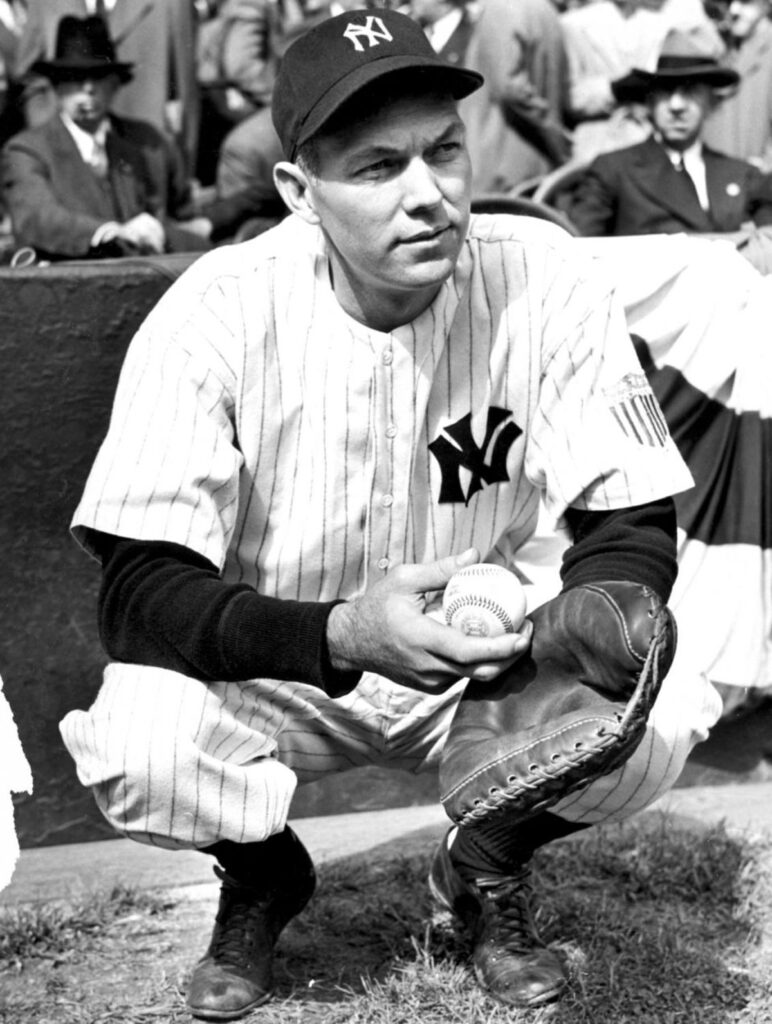
Later career as player-manager
In the following two years, Bill Dickey’s playing time experienced a noticeable decline, with his participation in fewer than 90 games each season, resulting in less than 300 at-bats annually. Remarkably, within the limited span of 242 at-bats during 1943, he exhibited his skill by achieving an impressive .351 batting average. The Yankees maintained their grip on the pennant in both 1942 and 1943, engaging in epic World Series clashes against the St. Louis Cardinals during each of these years. The Cardinals emerged victorious in the 1942 showdown, while the Yankees clinched the title in ’43. Each of these Series extended to five games, and Bill Dickey stood resolute behind the plate throughout. His defining moment unfolded in Game Five of the 1943 Series, where his two-run homer played a pivotal role in the Yankees’ 2-0 triumph.
In 1942 and 1943, Bill Dickey continued to proudly wear the Yankees’ uniform. However, his journey took an unexpected turn as he missed the 1944 and 1945 seasons due to his service in the military. Bill Dickey embarked on his naval service on June 3, 1944, holding the rank of lieutenant junior grade. During his time in the Pacific, he assumed the role of an athletic officer and notably managed the Navy team that secured victory in the 1944 Service World Series in Hawaii.
Upon his return from military service in 1946, Bill Dickey found the New York Yankees under new ownership. The team, once a dominant force, now bore the marks of aging players, a fact starkly evident as the Boston Red Sox surged ahead, securing a substantial lead and ultimately clinching the pennant. In contrast, the Yankees struggled, culminating in a disappointing third-place finish, a staggering 17 games behind the victorious Red Sox.
In May, a significant change unfolded when Joe McCarthy, the Yankees’ manager, resigned from his post. Bill Dickey stepped into the role of team leader for the remainder of the 1946 season and was also entrusted with managing the team in 1947. As a manager, he made a crucial decision to delegate the bulk of the catching duties to Aaron Robinson. Under Bill Dickey’s guidance, the Yankees posted a record of 57-48. However, when he sought clarity from the new owner, Larry MacPhail, regarding his future status as the team’s manager, MacPhail declined to provide a commitment. Consequently, Bill Dickey faced the difficult decision to resign, relinquishing the position with 14 games remaining in the season.
Despite this managerial setback, Bill Dickey assumed the helm of a team in 1947, leading the Little Rock Travelers in the Southern Association. Unfortunately, it proved to be a challenging season, as the team languished in last place, concluding with a record of 51-103.
The winds of change continued to sweep through the Yankees organization, as MacPhail departed after their triumphant 1947 World Series victory. George Weiss stepped in as the new general manager and, in a moment of synergy, reintroduced Bill Dickey to the Yankees fold. He took on the role of first-base coach and, in addition to his coaching responsibilities, he was tasked with mentoring the young and promising Yogi Berra.
During his retirement years in the 1970s and 1980s, Bill Dickey sought solace in the serene community of Yarborough Landing, nestled along the shores of Millwood Lake in southwestern Arkansas. It was in Little Rock, Arkansas, where Bill Dickey drew his final breath in 1993, leaving behind an enduring legacy in the world of baseball.
The legacy
Bill Dickey received the prestigious honor of being elected to the Hall of Fame in 1954, a moment he cherished as “the nicest thing ever to happen to me.”
Following his retirement from baseball in 1959, Bill Dickey briefly returned to the field in 1963 to assist Casey Stengel, the manager of the New York Mets, during spring training. He contributed his knowledge by tutoring catchers for a short period and made occasional appearances at Yankee Stadium for special events. Notable instances include the retirement of his No. 8 jersey in 1972 and the presentation of a plaque in Monument Park in his honor in 1988.
Over the course of his remarkable 17-year career, Bill Dickey participated in eight World Series, emerging victorious in seven of them. He earned the distinction of being named to the All-Star Team a remarkable 11 times and played in eight of these prestigious games. His prowess behind the plate was underscored by a remarkable fielding percentage of .988 in 1,708 games as a catcher. Bill Dickey boasted a career batting average of .313 and an impressive .382 on-base percentage. Remarkably, in 6,300 career at-bats, he only struck out 289 times, and he achieved a batting average of over .300 in 11 out of his 17 seasons.
Fellow Hall of Famer Bob Feller paid Bill Dickey one of the highest compliments by declaring, “Bill Dickey is the best (catcher) I ever saw.” Feller emphasized Bill Dickey’s excellence both defensively and with the bat, highlighting his pivotal role in the success of his team. He even believed that with Bill Dickey as his catcher, he could have won 35 games.
In 1972, the New York Yankees paid tribute to Bill Dickey and Yogi Berra by retiring the number 8 in their honor. On August 22, 1988, the Yankees further recognized their contributions by hanging plaques in Monument Park at Yankee Stadium.
Bill Dickey earned a well-deserved place in the annals of baseball history when he was named in 1999 to The Sporting News list of Baseball’s Greatest Players, ranking at number 57 among all-time greats. Among catchers, he followed behind Johnny Bench, Josh Gibson, Yogi Berra, and Roy Campanella.
In 2007, Dickey-Stephens Park, located in North Little Rock, Arkansas, was named in honor of Bill Dickey, his brother George, and two prominent Arkansas businessmen, Jackson and Witt Stephens.
The Bob Feller Act of Valor Award recognized Bill Dickey’s service in the United States Navy during World War II in 2013. He was one of 37 Baseball Hall of Fame members honored for their contributions.
Even while still an active player in 1942, Bill Dickey made appearances as himself in two notable films: “The Pride of the Yankees” (1942), which starred Gary Cooper as Lou Gehrig, and “The Stratton Story” (1949).
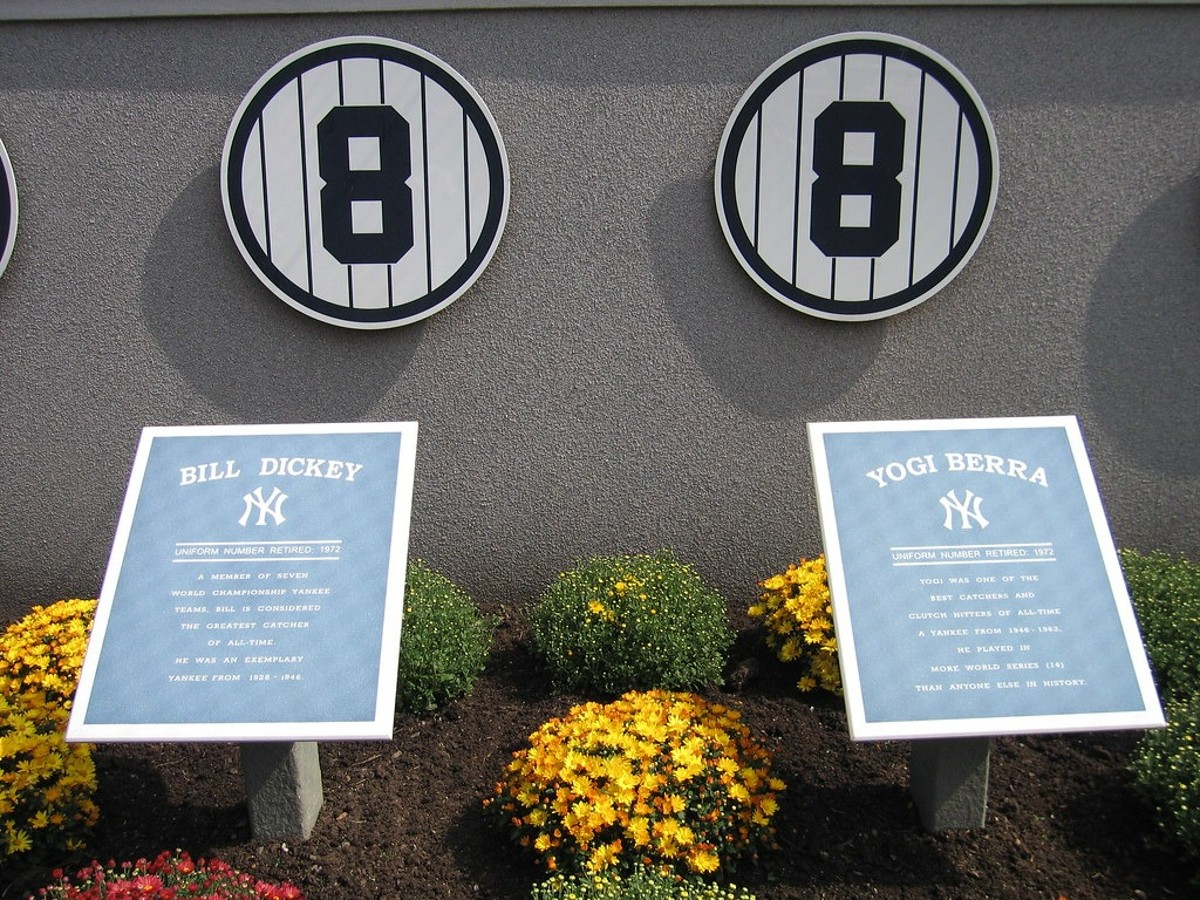
Greatest moments and awards
- Bill Dickey set an ambitious goal of catching in 100 games for the Yankees in 1929, an opportunity rarely given to rookie catchers. He beat the goal.
- In 1931, he drove in 7 runs against the Browns with two home runs – a grand slam and a 3-run blast. He managed 10 triples in 1931 on the way to a .327 batting average. He went the entire year – 125 games behind the plate – without committing a single passed ball.
- In Game 2 of the 1936 World Series, Bill Dickey and Tony Lazzeri tied a Series record with 5 RBIs in the game. The catcher hit a 3-run shot off the Giants’ Harry Gumbert.
- Bill Dickey mentored young Yankee backstops as his career wound down. Yogi Berra said: “I owe everything I did in baseball to Bill Dickey. He was a great man.”
- 11-time All-Star.
- Seven-time World Series champion.
- Elected to the Baseball Hall of Fame in 1954.
- Named by The Sporting News to its All-Star Team in 1937.
- Received MVP votes and All-Star selections throughout his career.
FAQs
Who was Bill Dicky?
Bill Dickey was an American professional baseball catcher and manager who played in Major League Baseball with the New York Yankees for 19 seasons. He was born on June 6, 1907, in Bastrop, Louisiana, and died on November 12, 1993, in Little Rock, Arkansas.
How old was Bill Dicky when he died?
Bill Dickey died at the age of 86.
When did Bill Dicky debut for the Yankees?
Dickey made his MLB debut with the Yankees on August 15, 1928.
When and where Bill Dicky died?
Bill Dickey died on November 12, 1993, in Little Rock, Arkansas.
Why did Bill Dickey and Yogi Berra have the same number?
Bill Dickey and Yogi Berra both wore the number 8 for the Yankees. Berra was Dickey’s protégé, and Dickey coached Berra in the art of catching. Berra later said, “I owe everything I did in baseball to Bill Dickey. He was a great man.”
How much is an 8×10 autograph of Bill Dickey worth?
There is no definitive answer to this question, as the value of an autograph can vary depending on factors such as the condition of the item, the rarity of the signature, and the demand among collectors. However, signed photos of Dickey are available for purchase online for prices ranging from around $50 to several hundred dollars.
How much is a Bill Dickey card worth?
The value of a Bill Dickey card can vary depending on factors such as the year, the condition of the card, and the rarity of the card. For example, a 1936 Bill Dickey card in good condition can be worth several hundred dollars, while a more common card from a later year might be worth only a few dollars.
Why is Bill Dickey’s number retired?
Dickey’s number 8 was retired by the Yankees in 1972. He was a key player on eight World Series championship teams and was widely regarded as one of the greatest catchers in baseball history. The Yankees retired his number as a tribute to his contributions to the team.
How much is a 1936 Bill Dickey card worth?
A 1936 Bill Dickey card can be worth several hundred dollars, depending on the condition of the card. For example, a 1936 Goudey Bill Dickey card in good condition can be worth around $500.
What did other players think of Bill Dickey?
Other players regarded Dickey as one of the greatest catchers in baseball history. Bob Feller, a Hall of Fame pitcher, said, “Bill Dickey is the best (catcher) I ever saw… He was as good as anyone behind the plate, and better with the bat. There are others I’d include right behind Dickey, but he was the best all-around catcher of them all.”
What years did Bill Dickey play for the Yankees?
Dickey played for the Yankees from 1928 to 1943 and in 1946.
What position did Bill Dickey play for the Yankees?
Dickey played as a catcher for the Yankees.
How many World Series did Bill Dickey win?
Dickey won eight World Series championships with the Yankees.
When did Bill Dicky manage the Yankees?
Dickey managed the Yankees as a player-manager in 1946 in his last season as a player.
When did Bill Dicky retire?
Dickey retired from playing baseball after the 1943 season, but he returned to the Yankees as a player-manager in 1946. He retired from managing after the 1946 season.
When was Bill Dicky inducted into HoF?
Bill was inducted into the Baseball Hall of Fame in 1954.
Which number Bill Dicky had?
Dickey wore the number 8 for the Yankees.
How many rings Bill Dicky had?
Bill Dickey won eight World Series championships with the Yankees.
Bill Dickey stats
Summary
| SUMMARY | WAR | AB | H | HR | BA | R | RBI | SB | OBP | SLG | OPS | OPS+ |
| Career | 56.3 | 6300 | 1969 | 202 | 0.313 | 930 | 1209 | 36 | 0.382 | 0.486 | 0.868 | 127 |
Standard batting
| Year | Age | Tm | Lg | G | PA | AB | R | H | 2B | 3B | HR | RBI | SB | CS | BB | SO | BA | OBP | SLG | OPS | OPS+ | TB | GDP | HBP | SH | SF | IBB | Pos | |
| 1928 | 21 | NYY | AL | 10 | 16 | 15 | 1 | 3 | 1 | 1 | 0 | 2 | 0 | 0 | 0 | 2 | 0.2 | 0.2 | 0.4 | 0.6 | 55 | 6 | 0 | 0 | 0 | H/2 | |||
| 1929 | 22 | NYY | AL | 130 | 474 | 447 | 60 | 145 | 30 | 6 | 10 | 65 | 4 | 6 | 14 | 16 | 0.324 | 0.346 | 0.485 | 0.832 | 117 | 217 | 1 | 11 | 4 | *2H | |||
| 1930 | 23 | NYY | AL | 109 | 396 | 366 | 55 | 124 | 25 | 7 | 5 | 65 | 7 | 1 | 21 | 14 | 0.339 | 0.375 | 0.486 | 0.861 | 120 | 178 | 0 | 9 | 3 | 2H | |||
| 1931 | 24 | NYY | AL | 130 | 524 | 477 | 65 | 156 | 17 | 10 | 6 | 78 | 2 | 1 | 39 | 20 | 0.327 | 0.378 | 0.442 | 0.82 | 119 | 211 | 0 | 7 | 4 | *2/H | |||
| 1932 | 25 | NYY | AL | 108 | 459 | 423 | 66 | 131 | 20 | 4 | 15 | 84 | 2 | 4 | 34 | 13 | 0.31 | 0.361 | 0.482 | 0.843 | 121 | 204 | 0 | 2 | 7 | *2/H | |||
| 1933 | 26 | NYY | AL | 130 | 532 | 478 | 58 | 152 | 24 | 8 | 14 | 97 | 3 | 4 | 47 | 14 | 0.318 | 0.381 | 0.49 | 0.871 | 135 | 234 | 2 | 5 | 9 | *2/H | |||
| 1934 | 27 | NYY | AL | 104 | 438 | 395 | 56 | 127 | 24 | 4 | 12 | 72 | 0 | 3 | 38 | 18 | 0.322 | 0.384 | 0.494 | 0.878 | 131 | 195 | 2 | 3 | 4 | *2/H | |||
| 1935 | 28 | NYY | AL | 120 | 491 | 448 | 54 | 125 | 26 | 6 | 14 | 81 | 1 | 1 | 35 | 11 | 0.279 | 0.339 | 0.458 | 0.797 | 109 | 205 | 6 | 2 | 2 | *2/H | |||
| 1936 | 29 | NYY | AL | 112 | 472 | 423 | 99 | 153 | 26 | 8 | 22 | 107 | 0 | 2 | 46 | 16 | 0.362 | 0.428 | 0.617 | 1.045 | 158 | 261 | 3 | 0 | 7 | *2/H | |||
| 1937 | 30 | NYY | AL | 140 | 609 | 530 | 87 | 176 | 35 | 2 | 29 | 133 | 3 | 2 | 73 | 22 | 0.332 | 0.417 | 0.57 | 0.987 | 144 | 302 | 4 | 1 | 13 | *2/H | |||
| 1938 | 31 | NYY | AL | 132 | 533 | 454 | 84 | 142 | 27 | 4 | 27 | 115 | 3 | 0 | 75 | 22 | 0.313 | 0.412 | 0.568 | 0.981 | 143 | 258 | 2 | 1 | 11 | *2/H | |||
| 1939 | 32 | NYY | AL | 128 | 565 | 480 | 98 | 145 | 23 | 3 | 24 | 105 | 5 | 0 | 77 | 37 | 0.302 | 0.403 | 0.513 | 0.915 | 133 | 246 | 9 | 4 | 4 | 6 | *2/H | ||
| 1940 | 33 | NYY | AL | 106 | 424 | 372 | 45 | 92 | 11 | 1 | 9 | 54 | 0 | 3 | 48 | 32 | 0.247 | 0.336 | 0.355 | 0.691 | 82 | 132 | 7 | 2 | 2 | 5 | 2/H | ||
| 1941 | 34 | NYY | AL | 109 | 397 | 348 | 35 | 99 | 15 | 5 | 7 | 71 | 2 | 1 | 45 | 17 | 0.284 | 0.371 | 0.417 | 0.788 | 109 | 145 | 10 | 3 | 1 | 12 | *2/H | ||
| 1942 | 35 | NYY | AL | 82 | 295 | 268 | 28 | 79 | 13 | 1 | 2 | 37 | 2 | 2 | 26 | 11 | 0.295 | 0.359 | 0.373 | 0.732 | 108 | 100 | 12 | 1 | 0 | 7 | 2/H | ||
| 1943 | 36 | NYY | AL | 85 | 284 | 242 | 29 | 85 | 18 | 2 | 4 | 33 | 2 | 1 | 41 | 12 | 0.351 | 0.445 | 0.492 | 0.937 | 173 | 119 | 5 | 0 | 1 | 5 | 2H | ||
| 1944 | Did not play in major or minor leagues (Military Service) | ||||||||||||||||||||||||||||
| 1945 | Did not play in major or minor leagues (Military Service) | ||||||||||||||||||||||||||||
| 1946 | 39 | NYY | AL | 54 | 156 | 134 | 10 | 35 | 8 | 0 | 2 | 10 | 0 | 1 | 19 | 12 | 0.261 | 0.357 | 0.366 | 0.723 | 101 | 49 | 6 | 1 | 2 | 2 | 2H | ||
| 17 Yrs | 1789 | 7065 | 6300 | 930 | 1969 | 343 | 72 | 202 | 1209 | 36 | 32 | 678 | 289 | 0.313 | 0.382 | 0.486 | 0.868 | 127 | 3062 | 49 | 31 | 51 | 101 | ||||||
| 162 Game Avg. | 162 | 640 | 570 | 84 | 178 | 31 | 7 | 18 | 109 | 3 | 3 | 61 | 26 | 0.313 | 0.382 | 0.486 | 0.868 | 127 | 277 | 3 | 5 | 9 | |||||||
Postseason batting
| Year | Age | Tm | Lg | Series | Opp | Rslt | G | PA | AB | R | H | 2B | 3B | HR | RBI | SB | CS | BB | SO | BA | OBP | SLG | OPS | TB | GDP | HBP | SH | SF | IBB | WPA | cWPA | |
| 1928 | 21 | NYY | AL | WS | STL | W | Did not play in series | |||||||||||||||||||||||||
| 1932 | 25 | NYY | AL | WS | CHC | W | 4 | 19 | 16 | 2 | 7 | 0 | 0 | 0 | 4 | 0 | 1 | 2 | 1 | 0.438 | 0.526 | 0.438 | 0.964 | 7 | 1 | 0 | 1 | 0.24 | 7.60% | |||
| 1936 | 29 | NYY | AL | WS | NYG | W | 6 | 28 | 25 | 5 | 3 | 0 | 0 | 1 | 5 | 0 | 0 | 3 | 4 | 0.12 | 0.214 | 0.24 | 0.454 | 6 | 0 | 0 | 0 | -0.39 | -10.70% | |||
| 1937 | 30 | NYY | AL | WS | NYG | W | 5 | 21 | 19 | 3 | 4 | 0 | 1 | 0 | 3 | 0 | 0 | 2 | 2 | 0.211 | 0.286 | 0.316 | 0.602 | 6 | 0 | 0 | 0 | -0.09 | -1.30% | |||
| 1938 | 31 | NYY | AL | WS | CHC | W | 4 | 16 | 15 | 2 | 6 | 0 | 0 | 1 | 2 | 1 | 0 | 1 | 0 | 0.4 | 0.438 | 0.6 | 1.038 | 9 | 0 | 0 | 0 | -0.01 | 2.30% | |||
| 1939 | 32 | NYY | AL | WS | CIN | W | 4 | 16 | 15 | 2 | 4 | 0 | 0 | 2 | 5 | 0 | 0 | 1 | 2 | 0.267 | 0.313 | 0.667 | 0.979 | 10 | 0 | 0 | 0 | 0 | 0.43 | 8.00% | ||
| 1941 | 34 | NYY | AL | WS | BRO | W | 5 | 21 | 18 | 3 | 3 | 1 | 0 | 0 | 1 | 0 | 0 | 3 | 1 | 0.167 | 0.286 | 0.222 | 0.508 | 4 | 1 | 0 | 0 | 0 | 0.01 | -1.80% | ||
| 1942 | 35 | NYY | AL | WS | STL | L | 5 | 20 | 19 | 1 | 5 | 0 | 0 | 0 | 0 | 0 | 0 | 1 | 0 | 0.263 | 0.3 | 0.263 | 0.563 | 5 | 0 | 0 | 0 | 0 | 0.07 | 0.50% | ||
| 1943 | 36 | NYY | AL | WS | STL | W | 5 | 20 | 18 | 1 | 5 | 0 | 0 | 1 | 4 | 0 | 0 | 2 | 2 | 0.278 | 0.35 | 0.444 | 0.794 | 8 | 1 | 0 | 0 | 1 | 0.3 | 9.40% | ||
| 8 Yrs (8 Series) | 38 | 161 | 145 | 19 | 37 | 1 | 1 | 5 | 24 | 1 | 1 | 15 | 12 | 0.255 | 0.329 | 0.379 | 0.709 | 55 | 1 | 0 | 2 | 0.55 | 14.10% | |||||||||
| 9 WS | 38 | 161 | 145 | 19 | 37 | 1 | 1 | 5 | 24 | 1 | 1 | 15 | 12 | 0.255 | 0.329 | 0.379 | 0.709 | 55 | 1 | 0 | 2 | 0.55 | 14.10% | |||||||||
Career graph
| Hall of Fame | All-Star Game | MVP (rank, share) | Wins Above Replacement |
| 1945 BBWAA ( 6.9%)1946 Final Ballot (12.2%) 1946 Nominating Vote (19.8%) 1948 BBWAA (32.2%) 1949 BBWAA (42.5%) 1949 Run Off (20.9%) 1950 BBWAA (46.4%) 1951 BBWAA (52.2%) 1952 BBWAA (59.4%) 1953 BBWAA (67.8%) 1954 BBWAA (80.2%) Selected to HOF in 1954 by BBWAA | 19331934 (C) 1936 * 1937 (C) 1938 (C) 1939 (C) 1940 (C) 1941 (C) 1942 1943 1946 * | 1932 AL (14, 10%)1933 AL (12, 11%) 1936 AL (5, 36%) 1937 AL (5, 28%) 1938 AL (2, 57%) 1939 AL (6, 33%) 1941 AL (13, 5%) 1942 AL (17, 4%) 1943 AL (8, 17%) 2.02 Career Shares (103rd) | 1937 AL 6.5 (8th)Career 56.3 (229th) |
| WAR Position Players | Offensive WAR | Defensive WAR | Batting Average |
| 1936 AL 5.9 (6th)1937 AL 6.5 (6th) 1938 AL 5.0 (10th) 1939 AL 5.4 (10th) Career 56.3 (144th) | 1936 AL 5.4 (7th)1937 AL 5.7 (6th) 1939 AL 5.1 (8th) Career 52.0 (162nd) | 1931 AL 0.8 (9th)1935 AL 0.7 (9th) 1937 AL 1.3 (4th) 1938 AL 0.7 (9th) 1940 AL 0.8 (10th) 1941 AL 0.9 (6th) | 1933 AL .318 (9th)1936 AL .362 (3rd) 1937 AL .332 (9th) Career .313 (87th) |
| On-Base% | Slugging % | On-Base Plus Slugging | Home Runs |
| 1936 AL .428 (6th)1937 AL .417 (5th) 1938 AL .412 (10th) Career .382 (167th) | 1933 AL .490 (6th)1936 AL .617 (5th) 1937 AL .570 (6th) 1938 AL .568 (6th) Career .486 (181st) | 1933 AL .871 (6th)1936 AL 1.045 (4th) 1937 AL .987 (5th) 1938 AL .981 (5th) Career .868 (129th) | 1933 AL 14 (9th)1936 AL 22 (8th) 1937 AL 29 (7th) 1938 AL 27 (8th) 1939 AL 24 (7th) |
| Runs Batted In | Adjusted OPS+ | Runs Created | Adj. Batting Runs |
| 1937 AL 133 (4th)1938 AL 115 (6th) 1939 AL 105 (8th) Career 1,209 (150th) | 1933 AL 135 (5th)1936 AL 158 (2nd) 1937 AL 144 (7th) 1938 AL 143 (5th) 1939 AL 133 (9th) Career 127 (241st) | 1937 AL 124 (8th)Career 1,164 (232nd) | 1936 AL 38 (7th)1937 AL 37 (7th) 1938 AL 31 (10th) 1943 AL 25 (9th) Career 246 (219th) |
| Adj. Batting Wins | Extra Base Hits | Offensive Win % | Hit By Pitch |
| 1936 AL 3.3 (7th)1937 AL 3.4 (7th) 1938 AL 2.8 (10th) 1943 AL 2.7 (9th) Career 23.0 (240th) | 1937 AL 66 (9th) | 1933 AL .673 (7th)1936 AL .771 (4th) 1937 AL .735 (6th) 1938 AL .727 (4th) 1939 AL .674 (10th) Career .651 (224th) | 1935 AL 6 (2nd)1939 AL 4 (5th) 1941 AL 3 (10th) |
| Intentional Bases on Balls | AB per SO | AB per HR | Base-Out Runs Added (RE24) |
| 1929 AL 4 (7th)1930 AL 3 (7th) 1932 AL 7 (5th) 1933 AL 9 (1st) 1936 AL 7 (7th) 1937 AL 13 (2nd) 1938 AL 11 (3rd) 1939 AL 6 (8th) 1941 AL 12 (4th) 1942 AL 7 (9th) Career 101 (147th) | 1929 AL 27.9 (7th)1930 AL 26.1 (7th) 1931 AL 23.9 (9th) 1932 AL 32.5 (7th) 1933 AL 34.1 (3rd) 1934 AL 21.9 (4th) 1935 AL 40.7 (1st) 1936 AL 26.4 (6th) 1937 AL 24.1 (4th) 1941 AL 20.5 (7th) Career 21.8 (88th) | 1932 AL 28.2 (8th)1933 AL 34.1 (7th) 1935 AL 32.0 (10th) 1936 AL 19.2 (4th) 1937 AL 18.3 (6th) 1938 AL 16.8 (5th) 1939 AL 20.0 (8th) | 1936 AL 50.32 (8th)1937 AL 45.71 (5th) 1938 AL 45.54 (6th) 1939 AL 45.90 (7th) 1943 AL 20.17 (8th) Career 342.87 (129th) |
| Win Probability Added (WPA) | Situ. Wins Added (WPA/LI) | Championship WPA (cWPA) | Base-Out Wins Added (REW) |
| 1936 AL 5.1 (4th)1937 AL 4.1 (8th) 1938 AL 2.8 (10th) 1939 AL 3.4 (6th) 1943 AL 2.4 (7th) Career 27.0 (170th) | 1936 AL 4.4 (4th)1937 AL 3.8 (5th) 1938 AL 3.4 (9th) 1939 AL 2.9 (8th) 1943 AL 2.5 (3rd) Career 27.1 (168th) | 1932 AL 3.3 (9th)1936 AL 7.8 (3rd) 1937 AL 12.1 (3rd) 1939 AL 5.4 (5th) 1941 AL 4.1 (7th) 1943 AL 4.2 (4th) Career 51.9 (58th) | 1936 AL 4.5 (7th)1937 AL 4.1 (5th) 1938 AL 4.1 (6th) 1939 AL 4.2 (7th) 1943 AL 2.2 (8th) Career 32.1 (140th) |
| Def. Games as C | Putouts as C | Assists as C | Errors Committed as C |
| 1929 AL 127 (2nd)1930 AL 101 (2nd) 1931 AL 125 (2nd) 1932 AL 108 (3rd) 1933 AL 127 (5th) 1934 AL 104 (4th) 1935 AL 118 (3rd) 1936 AL 107 (5th) 1937 AL 137 (1st) 1938 AL 126 (2nd) 1939 AL 126 (1st) 1941 AL 104 (4th) Career 1,708 (19th) | 1929 AL 476 (2nd)1930 AL 418 (2nd) 1931 AL 670 (1st) 1932 AL 639 (2nd) 1933 AL 721 (1st) 1934 AL 527 (2nd) 1935 AL 536 (1st) 1936 AL 499 (2nd) 1937 AL 692 (1st) 1938 AL 518 (1st) 1939 AL 571 (1st) 1941 AL 422 (4th) Career 7,965 (39th) | 1929 AL 95 (1st)1930 AL 51 (4th) 1931 AL 78 (2nd) 1933 AL 82 (2nd) 1934 AL 49 (4th) 1935 AL 62 (4th) 1936 AL 61 (4th) 1937 AL 80 (1st) 1938 AL 74 (1st) 1939 AL 57 (5th) Career 954 (59th) | 1929 AL 12 (3rd)1930 AL 11 (1st) 1932 AL 9 (3rd) 1933 AL 6 (2nd) 1934 AL 8 (4th) 1936 AL 14 (2nd) 1938 AL 8 (3rd) 1942 AL 9 (4th) |
| Double Plays Turned as C | Passed Balls | Stolen Bases Allowed as C | Caught Stealing as C |
| 1929 AL 13 (1st)1930 AL 5 (5th) 1933 AL 15 (2nd) 1934 AL 13 (2nd) 1935 AL 7 (5th) 1936 AL 10 (3rd) 1937 AL 11 (4th) 1938 AL 7 (5th) 1939 AL 8 (4th) 1940 AL 9 (2nd) 1941 AL 11 (4th) 1942 AL 7 (4th) Career 137 (20th) | 1930 AL 5 (4th)1932 AL 7 (2nd) 1933 AL 10 (1st) 1934 AL 7 (3rd) 1935 AL 8 (3rd) 1936 AL 6 (5th) 1937 AL 5 (5th) 1938 AL 7 (4th) | 1929 AL 57 (2nd)1930 AL 46 (2nd) 1931 AL 55 (1st) 1932 AL 43 (4th) 1934 AL 48 (2nd) | 1929 AL 44 (2nd)1930 AL 27 (5th) 1931 AL 46 (1st) 1933 AL 36 (4th) 1935 AL 30 (2nd) 1936 AL 31 (3rd) 1937 AL 36 (2nd) 1938 AL 31 (2nd) 1939 AL 27 (4th) 1940 AL 25 (5th) Career 465 (75th) |
| Caught Stealing % | Range Factor/9Inn as C | Range Factor/Game as C | Fielding % as C |
| 1931 AL 45.5 (5th)1933 AL 56.3 (4th) 1935 AL 50.0 (2nd) 1936 AL 53.4 (2nd) 1937 AL 48.6 (1st) 1938 AL 47.0 (2nd) 1939 AL 42.9 (5th) 1941 AL 51.2 (1st) 1942 AL 60.0 (1st) 1943 AL 55.9 (3rd) Career 46.6 (67th) | 1929 AL 5.19 (4th)1930 AL 5.26 (2nd) 1931 AL 6.30 (1st) 1932 AL 6.68 (1st) 1933 AL 6.47 (1st) 1934 AL 5.68 (1st) 1935 AL 5.34 (1st) 1936 AL 5.59 (1st) 1937 AL 5.79 (3rd) 1938 AL 5.05 (5th) 1939 AL 5.14 (5th) 1942 AL 5.20 (5th) 1943 AL 5.40 (4th) | 1929 AL 4.50 (5th)1930 AL 4.64 (3rd) 1931 AL 5.98 (1st) 1932 AL 6.41 (1st) 1933 AL 6.32 (1st) 1934 AL 5.54 (1st) 1935 AL 5.07 (1st) 1936 AL 5.23 (1st) 1937 AL 5.64 (2nd) 1938 AL 4.70 (5th) 1939 AL 4.98 (3rd) 1942 AL 4.58 (5th) 1943 AL 5.06 (3rd) | 1929 AL .979 (4th)1931 AL .996 (1st) 1932 AL .987 (3rd) 1933 AL .993 (3rd) 1934 AL .986 (5th) 1935 AL .995 (1st) 1936 AL .976 (5th) 1937 AL .991 (2nd) 1938 AL .987 (4th) 1939 AL .989 (1st) 1940 AL .994 (2nd) 1941 AL .994 (1st) |
| Youngest | |||
| 1928 AL born 1907-06-06 (9th) |
Sources: Baseball-Reference
- Categories: bill dickey, Yankees legends, Yogi Berra
- Tags: bill dickey, Yankees legends, Yogi Berra


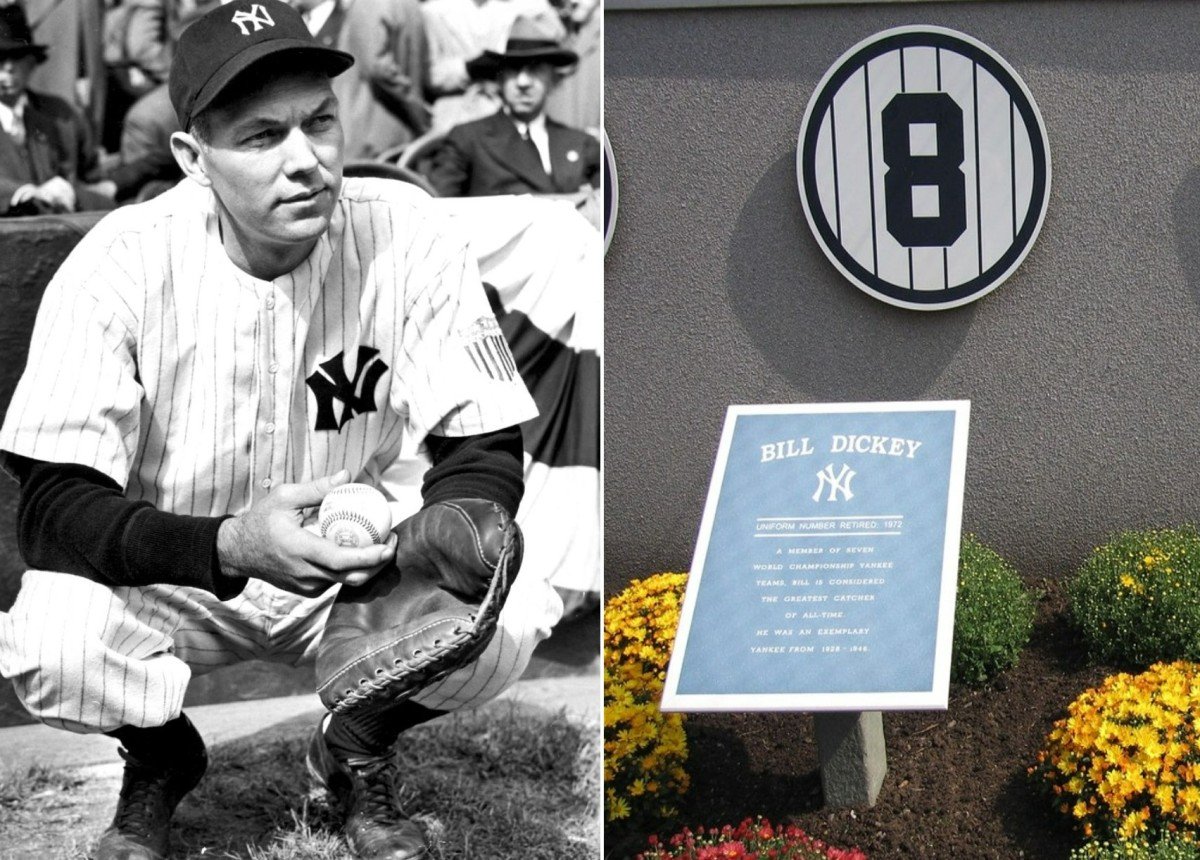
 Follow Us
Follow Us